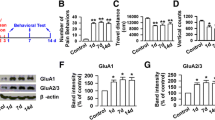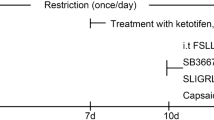Abstract
Background and Aim Synaptic plasticity plays an important role in affecting the intensity of visceral reflex. It may also be involved in the development of visceral hypersensitivity. The aim of this study was to investigate the role of synaptic plasticity on visceral hypersensitivity of rats infected by Trichinella spiralis. Methods Thirty male Sprague–Dawley (SD) rats were randomly divided into control, acute, and chronic infection groups, and were investigated at 1 week after adaptive feeding and at 2 and 8 weeks post infection (PI) by oral administration of 1 ml phosphate-buffered saline (PBS) containing 8,000 Trichinella spiralis larvae. Visceral sensitivity was evaluated by electromyography (EMG) recording during colorectal distension. Intestinal inflammation was observed by hematoxylin-eosin (HE) staining. Synaptic ultrastructure parameters, such as postsynaptic density (PSD) length, synaptic cleft, and number of synaptic vesicles, were examined by transmission electron microscopy (TEM). The expression of protein associated with synaptic plasticity, including postsynaptic density-95 (PSD-95), synaptophysin, calbindin-28 K, N-methyl-D-aspartate receptor-1 (NMDA-R1), α-amino-3-hydroxy-5-methylisoxazole-4-propionic acid receptor (AMPA-R), and glial cell line-derived neurotrophic factor (GDNF), were analyzed by Western blot. Results (1) Visceral hypersensitivity was noted in the chronic infection group, although the inflammation was nearly eliminated (P < 0.05). Severe inflammation and downregulation of visceral sensitivity were observed in the acute infection group (P < 0.05). (2) There were many more synaptic vesicles and longer PSD in the chronic infection group than in the control group (P < 0.05, respectively). However, in comparison with control rats, disappearance of mitochondria cristae in the synapses, and decrease of synaptic vesicles and length of PSD were observed in the acute infection group. There was no significant difference in width of synaptic cleft among the three groups. (3) Compared with the control, the expression of proteins associated with synaptic plasticity was significantly upregulated during chronic infection phase (P < 0.05), and downregulated during acute infection phase. Conclusion Synaptic plasticity was observed in SD rats infected by Trichinella spiralis and was associated with visceral sensitivity, which suggests that it may play an important role in the formation of visceral hypersensitivity.




Similar content being viewed by others
References
Read NW. Irritable bowel syndrome. In: Feldman M, Friedman LS, Sleisenger MH, eds. Gastrointestinal and liver disease. Philadelphia: Saunders; 2002:1794–1804.
Spiller RC. Postinfectious irritable bowel syndrome. Gastroenterology. 2003;124:1662–1671. doi:10.1016/S0016-5085(03)00324-X.
García Rodríguez LA, Ruigómez A, Wallander MA, Johansson S, Olbe L. Detection of colorectal tumor and inflammatory bowel disease during follow-up of patients with initial diagnosis of irritable bowel syndrome. Scand J Gastroenterol. 2000;35:306–311. doi:10.1080/003655200750024191.
Park H. The pathophysiology of irritable bowel syndrome: inflammation and motor disorder. Korean J Gastroenterol. 2006;47(2):101–110.
Accarino AM, Azpiroz F, Malagelada JR. Selective dysfunction of mechanosensitive intestinal afferents in irritable bowel syndrome. Gastroenterology. 1995;108:636–643. doi:10.1016/0016-5085(95)90434-4.
Mertz H, Naliboff B, Munakata J, Niazi N, Mayer EA. Altered rectal perception is a biological marker of patients with irritable bowel syndrome. Gastroenterology. 1995;109:40–52. doi:10.1016/0016-5085(95)90267-8.
Gershon MD. Nerves, reflexes, and the enteric nervous system: pathogenesis of the irritable bowel syndrome. J Clin Gastroenterol. 2005;39(suppl 3):S184–S193. doi:10.1097/01.mcg.0000156403.37240.30.
Grundy D. What activates visceral afferents? Gut. 2004; 53(suppl 2):ii5–ii8.
Park CH, Joo YE, Choi SK, Rew JS, Kim SJ, Lee MC. Activated mast cells infiltrate in close proximity to enteric nerves in diarrhea-predominant irritable bowel syndrome. J Korean Med Sci. 2003;18(2):204–210.
Gebhart GF. Pathobiology of visceral pain: molecular mechanisms and therapeutic implications IV. Visceral afferent contributions to the pathobiology of visceral pain. Am J Physiol Gastrointest Liver Physiol. 2000;278:G834–G838.
Barbara G, Stanghellini V, De Giorgio R, Cremon C, Cottrell GS, Santini D, et al. Activated mast cells in proximity to colonic nerves correlate with abdominal pain in irritable bowel syndrome. Gastroenterology. 2004;126(3):693–702. doi:10.1053/j.gastro.2003.11.055.
Giaroni C, Somaini L, Marino F, Cosentino M, Senaldi A, De Ponti F, et al. Modulation of enteric cholinergic neurons by hetero- and autoreceptors: cooperation among inhibitory inputs. Life Sci. 1999;65:813–821. doi:10.1016/S0024-3205(99)00308-2.
Lomax AE, Mawe GM, Sharkey KA. Synaptic facilitation and enhanced neuronal excitability in the submucosal plexus during experimental colitis in guinea-pig. J Physiol. 2005;564:863–875. doi:10.1113/jphysiol.2005.084285.
Dong WZ, Li ZS, Zou DW, Xu GM, Zou XP, Zhu AY, et al. The changes of mucosal mast cells and substance P in patients with irritable bowel syndrome. Zhonghua Nei Ke Za Zhi. 2003;42(9):611–614.
Del Valle-Pinero AY, Suckow SK, Zhou Q, Perez FM, Verne GN, Caudle RM. Expression of the N-methyl-D-aspartate receptor NR1 splice variants and NR2 subunit subtypes in the rat colon. Neuroscience. 2007;147(1):164–173. doi:10.1016/j.neuroscience.2007.02.063.
Linden DR, Sharkey KA, Mawe GM. Enhanced excitability of myenteric AH neurones in the inflamed guinea-pig distal colon. J Physiol. 2003;547:589–601. doi:10.1113/jphysiol.2002.035147.
Yang XD, Faber DS. Initial synaptic efficacy influences induction and expression of long-term changes in transmission. Proc Natl Acad Sci USA. 1991;88(10):4299–4303. doi:10.1073/pnas.88.10.4299.
Billy AJ, Walters ET. Long-term expansion and sensitization of mechanosensory receptive fields in Aplysia support an activity-dependent model of whole-cell sensory plasticity. J Neurosci. 1989;9(4):1254–1262.
Xu H, He J, Richardson JS, Li XM. The response of synaptophysin and microtubule-associated protein 1 to restraint stress in rat hippocampus and its modulation by venlafaxine. J Neurochem. 2004;91:1380–1388. doi:10.1111/j.1471-4159.2004.02827.x.
Thomas EA, Sjövall H, Bornstein JC. Computational model of the migrating motor complex of the small intestine. Am J Physiol Gastrointest Liver Physiol. 2004;286(4):564G–572G.
Galligan JJ. Enteric P2X receptors as potential targets for drug treatment of the irritable bowel syndrome. Br J Pharmacol. 2004;141(8):1294–1302. doi:10.1038/sj.bjp.0705761.
Bornstein JC, Furness JB, Smith TK, Trussell DC. Synaptic responses evoked by mechanical stimulation of the mucosa in morphologically characterized myenteric neurons of the guinea pig ileum. J Neurosci. 1991;11:505–518.
Smith TK, Bornstein JC, Furness JB. Convergence of reflex pathways excited by distension and mechanically deforming the mucosa onto morphologically characterized myenteric neurons of the guinea-pig small intestine. J Neurosci. 1992;12:1502–1510.
Castro GA, Fairbairn D. Carbohydrates and lipids in Trichinella spiralis larvae and their utilization in vitro. J Parasitol. 1969;55:51–58. doi:10.2307/3277345.
Kamp EH, Jones RCWIII, Tillman SR, Gebhart GF. Quantitative assessment and characterization of visceral nociception and hyperalgesia in mice. Am J Physiol Gastrointest Liver Physiol. 2003;284:G434.
Al Chaer ED, Kawasaki M, Pasricha PJ. A new model of chronic visceral hypersensitivity in adult rats induced by colon irritation during postnatal development. Gastroenterology. 2000;119:1276–1285. doi:10.1053/gast.2000.19576.
Pozzo Miller LD, Landis DM. Cytoplasmic structure in organotypic cultures of rat hippocampus prepared by rapid freezing and freeze-substitution fixation. Synapse. 1993;13(3):195–205. doi:10.1002/syn.890130302.
Landis DM, Payne HR, Weinstein LA. Changes in the structure of synaptic junctions during climbing fiber synaptogenesis. Synapse. 1989;4:281–293. doi:10.1002/syn.890040404.
Barbara G, Vallance BA, Collins SM. Persistent intestinal neuromuscular dysfunction after acute nematode infection in mice. Gastroenterology. 1997;113(4):1224–1232. doi:10.1053/gast.1997.v113.pm9322517.
Torrents D, Vergara P. In vivo changes in the intestinal reflexes and the response to CCK in the inflamed small intestine of the rat. Am J Physiol Gastrointest Liver Physiol. 2000;279(3):G543–G551.
Jacobson K, McHugh K, Collins SM. Experimental colitis alters myenteric nerve function at inflamed and noninflamed sites in the rat. Gastroenterology. 1995;109(3):718–722. doi:10.1016/0016-5085(95)90378-X.
Chen H, Duan LP, Zhu YL. Persistent intestinal motility disorder after transient intestinal nematode infection in rats. Beijing Da Xue Xue Bao. 2004;36(2):198–201.
Duan Li ping, Chen Hong, Wen Yan, Ye Si hong, Zhe Yuan li, Yang Yang ling. Development of a transient intestinal infection model in rat. Chin J Compar Med. 2003;13(3):142–145.
Bercík P, Wang L, Verdú EF. Visceral hyperalgesia and intestinal dysmotility in a mouse model of postinfective gut dysfunction. Gastroenterology. 2004;127(1):179–187. doi:10.1053/j.gastro.2004.04.006.
Xu-Friedman MA, Regehr WG. Structural contributions to short-term synaptic plasticity. Physiol Rev. 2004;84(1):69–85. doi:10.1152/physrev.00016.2003.
Harris KM, Sultan P. Variation in the number, location and size of synaptic vesicles provides an anatomical basis for the nonuniform probability of release at hippocampal CA1 synapses. Neuropharmacology. 1995;34:1387–1395 doi:10.1016/0028-3908(95)00142-S.
Wiedenmann B, Franke WW. Identification and localization of synaptophysin, an integral membrane glycoprotein of Mr 38,000 characteristic of presynaptic vesicles. Cell. 1985;41:1017–1028. doi:10.1016/S0092-8674(85)80082-9.
Becher A, Drenckhahn A, Pahner I, et al. The synaptophysin-synaptobrevin complex: a hallmark of synaptic vesicle maturation. J Neurosci. 1999;19:1922–1931.
Alder J, Kanki H, Valtorta F, Greengard P, Poo MM. Overexpression of synaptophysin enhances neurotransmitter secretion at Xenopus neuromuscular synapses. J Neurosci. 1995;15:511–519.
Alder J, Xie ZP, Valtorta F, Poo MM. Antibodies to synaptophysin interfere with transmitter secretion at neuromuscular synapses. Neuron. 1992;9:759–768. doi:10.1016/0896-6273(92)90038-F.
Swain MG, Agro A, Blennerhassett P, Stanisz A, Collins SM. Increased levels of substance P in the myenteric plexus of Trichinella-infected rats. Gastroenterology. 1992;102(6):1913–1919.
El Husseini AE, Schnell E, Chetkovich DM, Nicoll RA, Bredt DS. PSD-95 involvement in maturation of excitatory synapses. Science. 2000;290:1364–1368.
Tsukamoto M, Yasui T, Yamada MK, Nishiyama N, Matsuki N, Ikegaya Y. Mossy fibre synaptic NMDA receptors trigger non-Hebbian long-term potentiation at entorhino-CA3 synapses in the rat. J Physiol. 2003;546(Pt3):665–675. doi:10.1113/jphysiol.2002.033803.
Chen L, Chetkovich DM, Petralia RS, Sweeney N, Kawaski Y, Wenthold RJ, et al. Stargazin regulates synaptic targeting of AMPA receptors by two distinct mechanisms. Nature. 2000;408:936–943. doi:10.1038/35046031.
Mockett B, Coussens C, Abraham WC. NMDA receptor-mediated metaplasticity during the induction of long-term depression by low-frequency stimulation. Eur J Neurosci. 2002;15(11):1819–1826. doi:10.1046/j.1460-9568.2002.02008.x.
Delgado JY, Coba M, Anderson CN, et al. NMDA receptor activation dephosphorylates AMPA receptor glutamate receptor 1 subunits at threonine 840. J Neurosci. 2007;27(48):13210–13121.
Lin Y, Skeberdis VA, Francesconi A, Bennett MVL, Zukin RS. Postsynaptic density protein-95 regulates NMDA channel gating and surface expression. J Neurosci. 2004;24:10138–10148. doi:10.1523/JNEUROSCI.3159-04.2004.
Lavezzari G, McCallum J, Dewey CM, Roche KW. Subunit-specific regulation of NMDA receptor endocytosis. J Neurosci. 2004;24:6383–6391. doi:10.1523/JNEUROSCI.1890-04.2004.
Béïque JC, Lin DT, Kang MG, Aizawa H, Takamiya K, Huganir RL. Synapse-specific regulation of AMPA receptor function by PSD-95. Proc Natl Acad Sci USA. 2006;103(51):19535–19540. doi:10.1073/pnas.0608492103.
Chen W, Yang J, Shi J, Liu X, Guan X. Effects of electroacupuncture on the pain threshold and the NMDA R1 mRNA in DRG on neuropathic pain rats. J Huazhong Univ Sci Technolog Med Sci. 2003;23(2):108–111.
Zhou Q, Caudle RM, Price DD, Del Valle-Pinero AY, Verne GN. Selective up-regulation of NMDA-NR1 receptor expression in myenteric plexus after TNBS induced colitis in rats. Mol Pain. 2006;2(1):3. doi:10.1186/1744-8069-2-3.
Messenger JP, Bornstein JC, Furness JB. Electrophysiological and morphological classification of myenteric neurons in the proximal colon of the guinea-pig. Neuroscience. 1994;60(1):227–244. doi:10.1016/0306-4522(94)90217-8.
Chard PS, Jordán J, Marcuccilli CJ, Miller RJ, Leiden JM, Roos RP. Regulation of excitatory transmission at hippocampal synapses by calbindin D28 k. Proc Natl Acad Sci USA. 1995;92(11):5144–5148. doi:10.1073/pnas.92.11.5144.
Levi-Montalcini R, Skaper SD, Dal Toso R, Petrelli L, Leon A. Nerve growth factor: from neurotrophin to neurokine. Trends Neurosci. 1996;19:514–520. doi:10.1016/S0166-2236(96)10058-8.
Ribchester RR, Thomson D, Haddow LJ, Ushkaryov YA. Enhancement of spontaneous transmitter release at neonatal mouse neuromuscular junctions by the glial cell line-derived neurotrophic factor (GDNF). J Physiol. 1998;512(Pt 3):635–641. doi:10.1111/j.1469–7793.1998.635bd.x.
Focke PJ, Swetlik AR, Schilz JL, Epstein ML. GDNF and insulin cooperate to enhance the proliferation and differentiation of enteric crest-derived cells. J Neurobiol. 2003;55:151–164. doi:10.1002/neu.10204.
Liou JC, Yang RS, Fu WM. Regulation of quantal secretion by neurotrophic factors at developing motoneurons in Xenopus cell cultures. J Physiol. 1997;503:129–139. doi:10.1111/j.1469-7793.1997.129bi.x.
Wang LJ, Lu YY, Muramatsu S, Ikeguchi K, et al. Neuroprotective effects of glial cell line-derived neurotrophic factor mediated by an adeno-associated virus vector in a transgenic animal model of amyotrophic lateral sclerosis. J Neurosci. 2002;22:6920–6928.
von Boyen GB, Reinshagen M, Steinkamp M, Adler G, Kirsch J. Enteric nervous plasticity and development: dependence on neurotrophic factors. J Gastroenterol. 2002;37:583–588. doi:10.1007/s005350200093.
Acknowledgment
This work was supported by a grant from the National Natural Science Foundation of China (30670957).
Author information
Authors and Affiliations
Corresponding author
Rights and permissions
About this article
Cite this article
Yang, X., Sheng, L., Guan, Y. et al. Synaptic Plasticity: The New Explanation of Visceral Hypersensitivity in Rats with Trichinella spiralis Infection?. Dig Dis Sci 54, 937–946 (2009). https://doi.org/10.1007/s10620-008-0444-2
Received:
Accepted:
Published:
Issue Date:
DOI: https://doi.org/10.1007/s10620-008-0444-2




